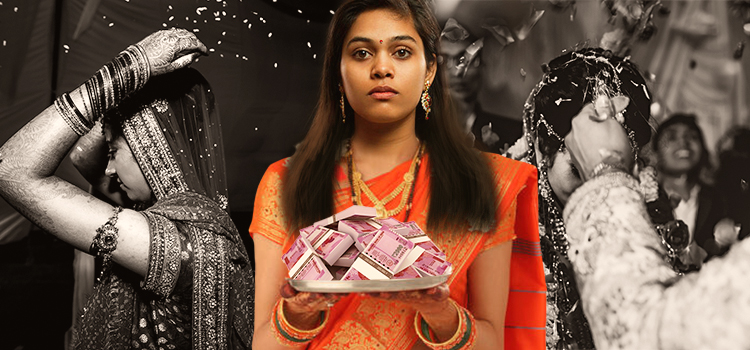Dowry still a Stigma in the Society
You all must remember that we used to write many essays and articles about dowry in our 6th and 7th class and then suddenly this topic vanished from the mainstream. While we thought that this evil practice has been eradicated from society but recently it shows that it is still a very much part of our society.
Well, first we should understand what dowry actually is? Dowry refers to the durable goods, property, or cash given by the bride's family to the groom's family. The dowry system puts a great burden on the family of the bride and that’s the sole reason families prefer sons over daughters. In some cases, the dowry system leads to emotional and physical abuse of the bride while sometimes it takes a tragic turn resulting in death.
While India has been making progress for women’s rights socially, Women are still subordinate in their own homes. Women’s education, wealth, and health are some significant factors that play into the dowry system.

Dowry to still persist in India there are factors behind it. Let’s take a look at them:-
1. Economic Factors
The concept of dowry started that women did not have any rights and were not allowed to inherit any property as they belonged only to their husband’s family after marriage.
It suggests how some of our legal institutions are weak and our women are at a disadvantage as only boys have all the right to inherit. This situation makes the woman's life miserable as she will be dependent on her husband and his family her whole life.
In 1956, the daughters were given equal legal status to sons under the Hindu Succession Act. Despite the new inheritance law, dowry still proceeds whereby parental property is given to the daughter at her marriage instead of after the parent's death as a supervised process under Hindu Succession Act.
2.Social Factors
The structure and kinship of marriage are often a major part that contributes to dowry. Every part of our country has a different concept and different rituals related to marriage. In the North, they usually follow the bride living with the groom’s family and the dowry is given as financial insurance for the bride. While in the South, marriage is more often conducted within the bride’s family. In addition, brides have the advantage to inherit more land and property which makes her valuable than the dowry.
In 1980 study conducted by Rao, it showed that 70% of the students didn’t have any interest in dowry while 40% of their parents were very much interested in taking dowry for their son. Often education is related to the main process to eradicate any malpractice or social inequalities. But research shows that highly educated grooms demand higher dowry prices. In some parts of India, dowry depends upon the education of the groom. If the groom is a Doctor, Engineer, or any government employee the dowry can easily go up to 1 to 2 crores. But a highly educated woman might be punished for that. As many families don’t want more earning daughters-in-law than their sons.
Some laws against dowry are
1.Dowry Prevention Act 1961
The Dowry Prevention Act of 1961 and later amendments aim to empower women to report dowry extortions. It is illegal to give or receive dowry in any form and is a punishable offence. The law recommended a minimum of five years of imprisonment or a fine as the same amount of dowry.
2. Criminal Statutes—-- Indian Penal code, Criminal Procedure Act, and Evidence Act
The Indian criminal law is heavily amended to make dowry a criminal offence. Section 304B has been added to the Indian Penal Code, 1860 (“IPC”), which made dowry death a specific offence punishable with a minimum imprisonment of 7years and maximum imprisonmnet for life. It provided that if the death of the woman is caused by burns or severe injuries or occurs in wary circumstances within 7year of marriage and if the evidence found against the groom or his family. The sentence will be given to them.
3. Protection of Women from Domestic Violence Act,2005
The act was passed in 2005 to provide a remedy for domestic violence against women. The domestic violence act confines all forms of physical, mental, verbal, emotional, or sexual abuse in the context of dowry. Section 3 of the Domestic Violence Act specifically incorporates all forms of harassment, injury, and harms inflicted to coerce a woman to meet any unlawful demand for dowry.
Even after all the laws dowry still persists in India. Even when the groom's family does not demand anything the bride’s family gives the dowry and often termed it “with love”, but in another word, it is because of social status and pride.
Instead of refusing dowry outright nowadays the groom’s family often uses the term “ give whatever you want to give to your daughter”. And just like that, the burden of dowry is shifted to the bride’s family in a very respectable way. And legally it would no longer be dowry.
There are many sides to the issue of dowry. Perhaps the only common positive is that the practice has been acknowledged for what it is, a form of oppression and injustice towards women. However, there lies a dark side to seeking an end to this practice: instead of treating dowry as an act of violence against women, it is seen as a form of charity. The very same people who wish to eliminate dowry think nothing of giving it away as a gift to older women. And in these two actions, we come across two major issues that characterise our society’s view on dowry: the view that if an individual doesn’t give the gift then they don’t contribute anything to the “cause”, and the older women not married off young deserve pity.